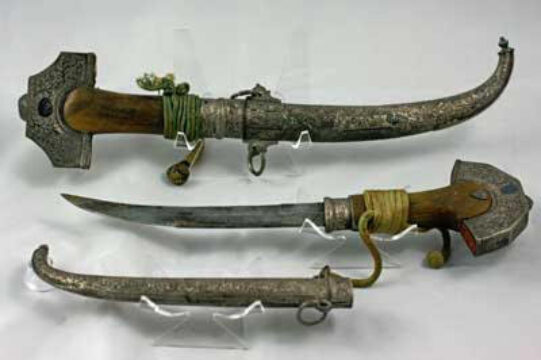
The Rosenberg Library Museum displayed a pair of Moroccan scimitars as the October Treasure of the Month. These scimitars were collected by Mr. Bernard Bernardoni (1903 – 1971), a Galveston resident and an economic analyst for the U.S. Department of State, in North Africa between 1939 and 1947.
Donated to the Library in 1971, these daggers are elaborately decorated and heavily ornamented with silver. Scimitars are backswords with curved blades that were originally created in South Asia or the Middle East. These swords are important elements of these Middle Eastern cultures, notably Indian, Turkish, and Saudi Arabian cultures, as well as Oriental and even British and American cultures.
The term “scimitar” itself has been part of the English language since 1548. Derived from the French “cimiterre” and the Italian “scimitarra,” scimitar is a well known word in most Middle Eastern languages. It is believed that it, and the sword that bears its name, is descended from the Persian word “shafsher,” meaning “lion’s claw,” that is also attributed to an ancient Persian curved sword known as a “shamshir.” However, controversy still surrounds the origins of the scimitar. Some believe the blades originated in Ancient Egypt in 1600 BCE as a khopesh, a hybrid weapon of sickle and sword. The scimitar may have also evolved from the Mongolian saber, which in turn developed from the Chinese broadsword, making the scimitar’s origins more relative to the curved blades of the Orient.
Scimitars were heavily used during the Mongolian invasions of the thirteenth and fourteenth centuries. These invasions influenced the Ottoman Turks to begin using a unique scimitar known as a kilj in the fifteenth century. The Napoleonic Wars of the late 19th century brought the blade to the attention of Europeans, and the kilj became popular among senior French and British officers. After the First Barbary Wars, U.S. Marines were presented with bejeweled kiljs or, as they are known in the U.S., mameluke swords. Mameluke swords are still presented to U.S. Marines as dress swords. Cutlasses, the famed swords of the high-seas, favored by pirates and privateers alike, are shorter and broader scimitars that are well-suited for close combat. They were used by British cavalry soldiers as well for their compact size made slashing from side to side effective without harming the soldiers’ horses’ ears.
Today, scimitars are most popular in belly dance acts, Hollywood films about piracy and the Middle East, and the fantasy worlds of books and video games. They are also often carried for ceremonial duties by various Eastern and Western militaries. These curved weapons have come to symbolize courage and strength in many Eastern cultures and appear on the Saudi Arabian coat of arms as well U.S. and British emblems and insignia. Scimitars today are treasured collectibles and symbolic reminders of Middle Eastern and western history and pride.